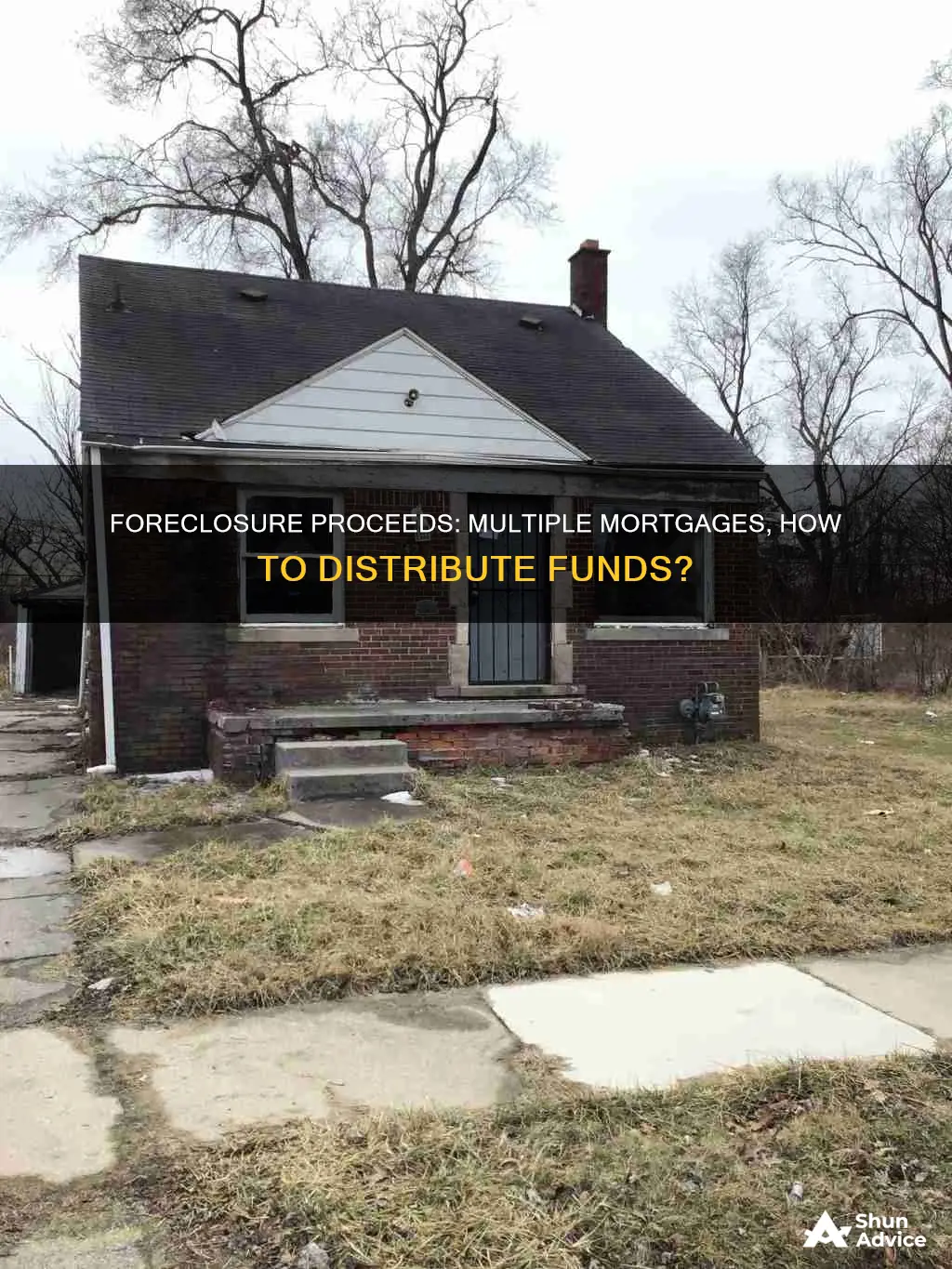
Foreclosure is a legal process that occurs when a borrower misses a certain number of mortgage payments. Typically, the foreclosure process begins when the lender files a suit in court, and the borrower has a limited window of time to make the payments before the property is put up for auction. The proceeds from the sale are then distributed to the creditors, with the first mortgage lender being paid off first, followed by the second mortgage lender, and any remaining funds going to the borrower. However, if the property sells for less than what is owed, the borrower may still be responsible for the remaining debt, known as a deficiency.
| Characteristics | Values |
|---|---|
| What is foreclosure? | The legal process of taking ownership of a property to sell it when the borrower misses a certain number of payments |
| Who can initiate foreclosure? | The first mortgage lender or the second mortgage lender |
| When is foreclosure initiated? | When the borrower misses a certain number of payments |
| What are the phases of foreclosure? | Payment default, notice of default, notice of trustee's sale, trustee's sale, REO, and eviction |
| What is the role of the court in foreclosure? | In a judicial foreclosure, the mortgage lender must file a suit in court. If the borrower cannot make their payments within 30 days, the property will be put up for auction by the local sheriff's office or court |
| What happens to liens and second mortgages in foreclosure? | First mortgage lenders are in the first lien position and are paid first from the proceeds of the foreclosure sale. Any surplus funds are then distributed to creditors holding junior liens, such as second mortgage lenders or judgment creditors |
| What happens if the proceeds of the foreclosure sale are not sufficient to cover all debts? | The second mortgage holder might look for other ways to collect from the borrower, such as filing a lawsuit for a money judgment or selling the debt to a collection agency |
| What is the impact of state laws on the foreclosure process? | The exact foreclosure process and the rights of lenders to take legal action depend on the laws of the specific state |
| What are the options for homeowners facing foreclosure? | Homeowners can consider loss mitigation options, such as forbearance plans or Chapter 13 bankruptcy, or consult with a housing counselor or foreclosure attorney to review their finances and explore alternatives |

Priority of liens
The priority of liens is a crucial factor in determining how foreclosure proceeds are distributed when multiple mortgages are involved. The principle of "first in time, first in right" generally applies, meaning that the lien recorded first in the land records has a higher priority over later-recorded liens. This principle, however, has some exceptions.
First mortgages, or "first deeds of trust," are typically recorded first and hold the highest priority. They are considered “senior” liens and are paid before "junior" liens, such as second and third mortgages. In the context of foreclosure, this means that the proceeds from the sale are used to pay off the first mortgage first, and any surplus funds are then distributed to creditors with junior liens. If there are insufficient funds to cover all lienholders, those with lower-priority liens may receive nothing.
Second and third mortgages are considered voluntary liens, which the homeowner chooses to place on the property. These liens are usually recorded after the first mortgage and hold a lower priority. While they are typically in the second and third lien positions, there can be exceptions. For example, certain liens, such as property tax liens, HOA (Homeowners' Association) liens, and mechanic's liens, may have automatic superiority over prior liens, depending on state and federal laws.
In some cases, a second mortgage holder may choose to initiate foreclosure proceedings if the homeowner stops making payments. However, if the home's value has decreased, the second mortgage holder may opt for "lien stripping" through Chapter 13 bankruptcy, which converts the second mortgage into unsecured debt, effectively lowering its priority.
It is important to note that the specific laws and procedures related to foreclosure and lien priority may vary from state to state. Therefore, consulting with a foreclosure attorney is advisable to understand the specific laws and options available in a particular situation.
Trulia Mortgage Estimates: How Reliable Are They?
You may want to see also

Surplus funds
When a property sells for more than the borrower owes on their mortgage loan, the extra money is called "surplus funds", "excess proceeds", or "overage". These surplus funds are the remaining balance after paying off the mortgage debt, fees, and foreclosure-related costs.
If there are multiple mortgages, the first mortgage lender will be paid in full first. Then, if there are any surplus funds remaining, the second mortgage lender will be paid off. For example, if a homeowner has a total debt of $200,000 on their first mortgage, a second mortgage of $40,000, and a creditor filed a $10,000 judgment lien, and the home sells for $250,000 at a foreclosure sale, the first mortgage lender will receive $200,000, the second mortgage lender will receive $40,000, and the judgment creditor will be paid the remaining $10,000. In this case, all creditors were paid in full, and the homeowner would not receive any surplus funds.
However, if the property sells for more than the total debt owed, the homeowner may be entitled to claim the surplus funds. For example, if a homeowner owes a total of $525,000 to the foreclosing lender, $15,000 to a second mortgage holder, and $5,000 to a judgment creditor, and the home sells for $550,000 at the foreclosure sale, the homeowner can claim the remaining $5,000.
It is important to note that the process for claiming surplus funds may vary depending on the location, and there may be specific procedures and timing requirements that need to be followed. In some cases, if the surplus funds go unclaimed, they may be transferred to the state or other designated parties after a certain period.
Zillow's Mortgage Estimates: Accurate or Misleading?
You may want to see also

Deficiency judgments
When a borrower misses a certain number of payments on their mortgage, the lender can begin the process of taking ownership of the property to sell it. This is known as foreclosure. Foreclosure is a legal process that has six typical phases: payment default, notice of default, notice of trustee's sale, trustee's sale, REO, and eviction. The exact foreclosure process varies depending on the state.
If the resale of the property does not pay off the borrower's full debt, the borrower may receive a deficiency judgment. A deficiency judgment is a court order that allows a lender to collect additional money from a borrower who has defaulted on a loan. The lender must demonstrate through comparable listings and a professional appraisal that the price received from selling the home was fair. The court decides the fair market value of the home. The amount of the deficiency judgment is equal to the amount of the debt minus the fair market value or the sale price, whichever is higher.
If the lender succeeds in obtaining a deficiency judgment, they can attempt to collect the money in several ways, including garnishing the borrower's wages, seizing other property, or taking money from the borrower's bank account. However, many states prohibit deficiency judgments after a home foreclosure, and they are not allowed in every state. In some cases, the borrower may be able to negotiate another repayment arrangement with the lender or challenge the deficiency judgment in court.
It is important to note that if the lender chooses not to pursue a deficiency judgment or does so unsuccessfully, the borrower may incur income tax liability for debt forgiveness. Therefore, it is advisable to hire an attorney to defend against a deficiency claim and explore possible modifications to the mortgage loan.
Incorporate Closing Costs: Folding Them into Your Mortgage
You may want to see also

State laws
The distribution of foreclosure proceeds is also subject to state laws. In general, proceeds are distributed according to the priority of liens, with tax liens taking precedence over mortgage lenders. The first mortgage lender is typically in the first lien position and is paid off first. Any remaining funds are then used to pay off the second mortgage lender, who holds a junior lien. If there are still funds available, they are distributed to additional junior lienholders, such as a third mortgage lender or judgment creditor. If the foreclosure sale proceeds are insufficient to cover all junior liens, some lienholders may not receive any payment.
Additionally, state laws may allow second mortgage lenders to pursue other legal avenues for debt recovery if they do not receive sufficient funds from the foreclosure sale. For example, the second mortgage lender may sue for the unpaid balance or sell the debt to a collection agency. In some cases, filing for Chapter 13 bankruptcy may help eliminate a second mortgage through a process called "lien stripping," where the second mortgage is converted into unsecured debt.
Explore ARM Mortgage Refinancing Options and Customer Strategies
You may want to see also

Bankruptcy
Foreclosure proceedings usually begin when a homeowner falls behind on their mortgage payments. Typically, a foreclosure begins after a homeowner misses multiple mortgage payments. The lender must follow the process outlined in state law before selling the home at auction and applying the sales proceeds toward the mortgage balance.
If the proceeds of a foreclosure sale do not cover the total balance that a homeowner owes their lenders, the remainder owed is called a deficiency balance. The mortgage is gone, but the promissory note remains. In such cases, bankruptcy can be filed to get rid of any remaining debt once the home is sold. Bankruptcy can stop a foreclosure in its tracks, even if the property is scheduled for auction the very next day. This is due to the automatic stay, a powerful legal protection that kicks in the moment a bankruptcy case is filed. The automatic stay directs creditors to stop most collection activities immediately, including foreclosure proceedings.
Chapter 7 bankruptcy will cancel any debt secured by the home, including the debt of junior mortgages or home equity loans. However, Chapter 7 bankruptcy will not help the homeowner keep their house. This is because it lacks a way to make up missed payments, an option available only in Chapter 13 bankruptcy. Chapter 13 bankruptcy may allow filers to keep their homes by catching up on payments and removing junior mortgages. If the sales proceeds would not pay off the entire first mortgage, there would be nothing left to pay toward junior mortgages. Filers can use lien stripping to save their homes by asking the Chapter 13 bankruptcy court to strip the junior mortgages that are not secured and re-categorize them as unsecured debt.
It is important to note that repeat bankruptcy filings will not help a homeowner avoid foreclosure. An automatic stay will generally last only for 30 days if the filer had a previous bankruptcy case dismissed in the last year, and it will not go into effect if the filer had two or more bankruptcy cases dismissed in the last year. Additionally, bankruptcy will negatively impact a debtor's credit score. However, foreclosure will also damage a debtor's credit score for years and does not eliminate other debt.
MyFICO's Mortgage Accuracy: Is It Reliable?
You may want to see also
Frequently asked questions
Foreclosure is the legal process of a lender taking ownership of a property to sell it when the borrower misses a certain number of payments on their mortgage.
The general rule is "first in time, first in right", meaning that the proceeds are distributed in the order of priority of the liens. First, unpaid property taxes are paid (if applicable). Second, the first mortgage lender is paid. Third, the second mortgage lender is paid. Finally, any remaining funds are distributed to any other creditors.
Any surplus funds from the foreclosure sale are distributed to the former homeowners.
If the property sells for less than the total debt owed, the property will be foreclosed, and the lender may sue the borrower for the unpaid balance.
In this case, the second mortgage can be converted into an unsecured debt, and the lender must release their lien from the property.







